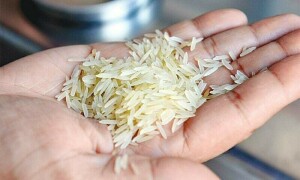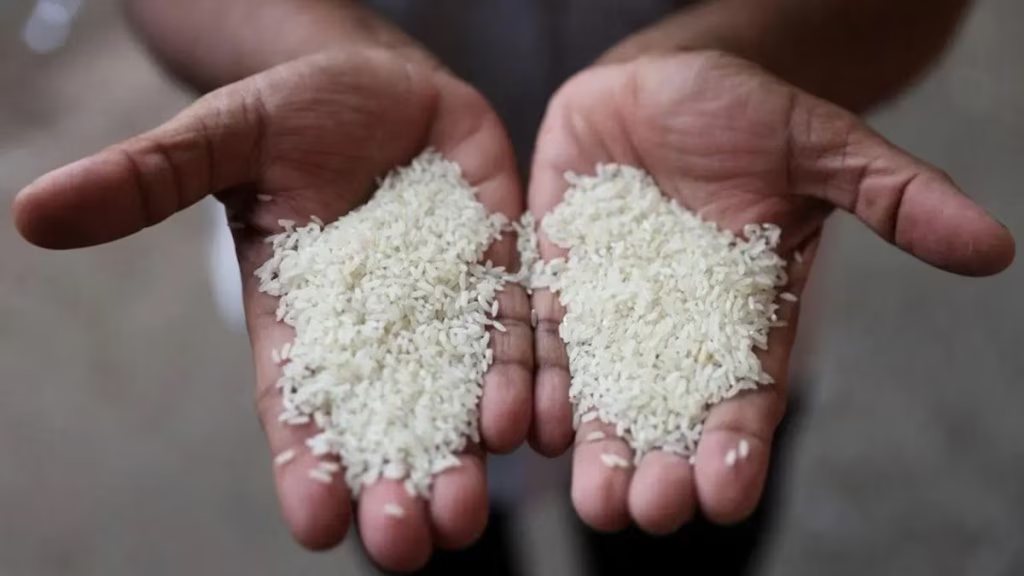Tags
Commentary: Rice export bans and price caps are a food crisis risk for Asia
Rice prices have risen since India restricted exports, leading some importing countries to cap domestic prices of rice. It’s an explosive cocktail, says Javier Blas for Bloomberg Opinion.

A man checks rice at a store in Quezon city, Philippines, on Aug 14, 2023. Countries worldwide are scrambling to secure rice after a partial ban on exports by India cut supplies by roughly a fifth. (AP Photo/Aaron Favila)
LONDON: It’s a diagram that Economics 101 students learn by heart. It puts together supply, demand and prices in a single chart. The graph is the stuff that makes markets tick, whether for iPhones or bowls of rice.
As an associate professor at the School of Economics at the University of the Philippines, prior to her move into government, Cielo Magno imprinted the supply-and-demand chart on her students’ minds. Typically, supply slopes upward: When prices rise, suppliers are willing to produce more; demand generally slopes downward: At higher prices, consumers buy less.
Then Magno became her country’s finance undersecretary, building a reputation for speaking her mind. On Sep 1, she posted a common version of the diagram on social media: “I miss teaching …,” she added. Soon after, she was fired.
Though Magno didn’t explicitly say it then, through her post, she was questioning the government’s decision to introduce a price cap for rice.
If the supply-demand diagram is Economics 101, then price caps are Government 101, distorting how markets are supposed to work. And rice is right now the target of many.
Sadly, Magno’s travails in the Philippines aren’t an exception. Across Asia, nations are trying to bend supply and demand curves, attempting to control the cereal grain’s prices. Carelessly, they are sowing the seeds of a potential food crisis.
EXPORT BANS, PRICE CAPS HURT
Global rice prices have risen to a 12-year high above US$600 a metric tonne since India, the world’s largest rice exporter, embarked on a beggar-thy-neighbour policy of reducing overseas sales. As a response, importers like the Philippines are doing the opposite, capping prices, in effect boosting demand.
Just imagine what happens to global wholesale prices when big exporters reduce supply just as large importers try to cap domestic prices. It’s an explosive cocktail, with international prices the only relief valve.
The price rally matters because rice is the staple diet for half the world, including about 1 billion undernourished people living in Asia and Africa. While most pundits focus on wheat, corn and soybeans, all heavily traded in the futures market in Chicago, for food security, rice’s physical transactions matter more.
Important as it is, very little rice trades between borders, with most of it consumed domestically. As such, small changes in exports and imports, and production and supply, have an outsize impact on world prices.
While global rice production in the last crop season was 513 million tonnes, global trade totalled just 10 per cent of that amount. By contrast, more than 25 per cent of wheat and 40 per cent of soybean output are traded, respectively.
ASIA’S RICE PROBLEM
Asia is struggling with a real problem: Rice harvests haven’t been as abundant as expected, largely due to droughts linked to the El Nino weather phenomenon. And the next crop season isn’t looking any better.
In theory, global rice stockpiles are more than sufficient to bridge any crop shortfall. At the end of the current 2022 to 2023 season, they are expected to stand at 173.8 million metric tonnes, more than double the 82 million over the 2007 to mid-2008 period, when rice prices last surged.
The problem is who holds those inventories: China and India control, together, just over 80 per cent. And neither is selling much.
All this began in July, when India announced a ban on exports of non-premium-quality rice and has since imposed further restrictions encompassing most of its overseas sales. True, New Delhi allows exports in ad hoc government-to-government deals, but those are cumbersome and far more arbitrary than previous commercial deals.
On paper, India has enough rice for itself and for export – but facing elections next year, the government of Prime Minister Narendra Modi isn’t taking any chances with food inflation.
In turn, importing countries panicked, introducing their own measures. And even the countries that didn’t impose formal restrictions saw their own problems as traders hoarded, fearing higher prices later.
The result: The beginning of a price panic that supply-and-demand analysis suggests is unneeded. True, the physical rice market is tighter than expected, but if regional governments were working together to avoid a crisis, one wouldn’t happen.
DEMAND FOR RICE RISING FAST
Sadly, the lessons of the 2007 to 2008 rice price spike, when the grain’s cost more than tripled in a few weeks to above US$1,000 a tonne, haven’t been heeded. Then export bans, price caps and hoarding made a difficult situation a tragedy. Asia risks the same result now.
Asian nations understandably need to protect their vulnerable populations from sharp increases in food costs, but they have more nuanced tools available than widespread export restrictions and one-size-fits-all price caps. Targeted support, including via strong welfare safety nets, works better – and it’s far cheaper.
The current trouble highlights the need to support more rice production. The good news is that Asian governments have learned several lessons from the 2007 to 2008 food crisis and stepped up help to their farmers, with production since then posting records almost every year.
Even in 2023, despite El Nino-linked droughts, output is expected to reach an all-time high. The bad news is that demand is rising even faster, boosted by booming population growth and a decline in extreme poverty in corners of Asia and Africa.
To keep up, governments need even more production. That’s tricky in an era of climate change when the world is trying to reduce its use of fertilisers and water.
One option is further investment in better seeds, including genetically modified ones. For years, China opposed genetically modified organisms; now it’s opening the door, starting with corn.
Another alternative is to improve farming infrastructure, including silos, to avoid crop losses after harvest. In the latter area, regional development banks could do much more to channel money.
Rather than trying to bend the supply-and-demand diagrams, Asia needs to embrace the curve, letting free markets work. Magno is back to teaching, this time a course about public economics. We can only hope some officials drop by her class.
https://www.channelnewsasia.com/world/us-committee-demands-reasons-lack-xinjiang-sanctions-3783336Published Date: September 19, 2023






